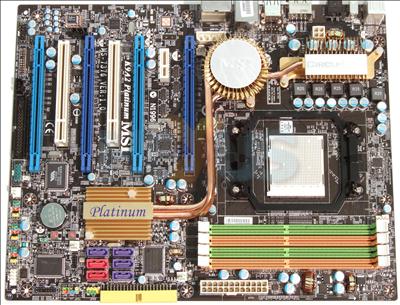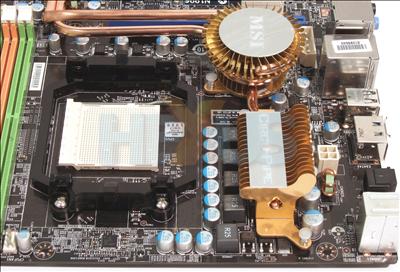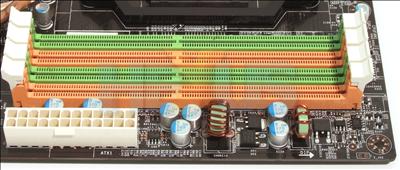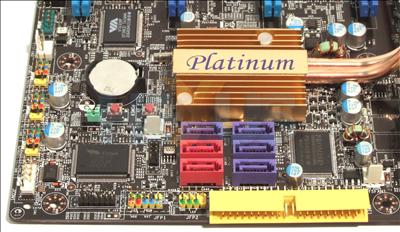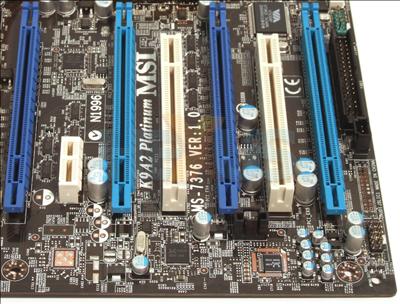MSI K9A2 Platinum layout and musings
The physical embodiment of 790FX from MSI's point of view, the K9A2 Platinum is, as per chipset mandate, designed for the extreme overclocker in mind.
MSI uses a variety of heatsink and heatpipes to cool the hot-running voltage-regulating components to one side of the CPU. Two heatpipes run from the SB600 southbridge and up to the Circu-Pipe-cooled RD790 northbridge, with a single pipe then heading on over to the heatsink.Patently they're not required for operation at default speeds and any such cooling will only come to the fore once the chipset is pushed with boosts to frequencies and voltages.
Happily, the does not impinge on the CPU-exclusion zone. Note, too, that the CPU socket is identical to that for AM2 processor, at least in appearance.
Continuing a theme that's prevalent for high-end boards, MSI uses solid capacitors to enhance longevity, especially when extra power is pumped through the board
Four DIMM slots support dual-channel DDR2-1066 memory. It's worth repeating that the processor's memory-controller can access system memory either as a single 128-bit load (ganging) or via two 64-bit loads (un-ganging). In terms of aesthetics, we like the fact that the power connectors are located at the edge of the board.
Moving on down, we see that MSI has augmented the SB600's meagre four-port SATA2 complement (purple-coloured) with the all-new Promise controller. That adds a couple of SATA2 ports and these also support SAS-ready (Serial-Attached Storage) drives. The single, yellow-coloured PATA/IDE port is provided via the SB600.
Four mechanical PCIe 2.0 x16 slots! The two dark blue slots can be considered primary - and that's where you'd place ATI graphics cards for dual-card CrossFire and take advantage of full-bandwidth connectivity.
However, as we know, a four-card CrossFire (CrossFireX) configuration is a future possibility. The driver will be made available in Q1 2008, according to AMD. Now, there aren't enough PCIe lanes to use x16 PCIe on a four-card setup, so the board negotiates down to x8/x8/x8/x8 as needed, although it's worth remembering that PCIe 2.0 innately has double the bandwidth of PCIe 1.1.
The uppermost PCIe x16 comes perilously close to fouling the northbridge's heatpipe. Also, while it is possible to install four double-width Radeon HD 3870s, you will lose access to the two conventional PCI slots and the single PCIe slot.
High-definition audio and a gigabit Ethernet controller are supplied by Realtek, while VIA provides two-port FireWire 1394a.
The Promise controller also provides a couple of eSATA ports on the back. We're almost at the stage where legacy serial and parallel ports are a thing of the past - though, as here, PS/2 seems to be holding on rather better.
In terms of layout, the standout feature is the provision of four mechanical x16 PCIe slots. Only a minority of readers are likely to contemplate a four-card gaming system, so the appeal is hugely niche but, right now, it remains an AMD-only option.






